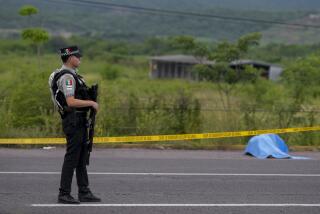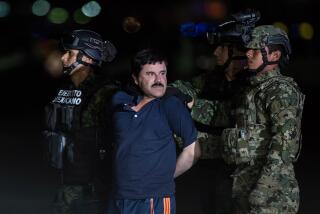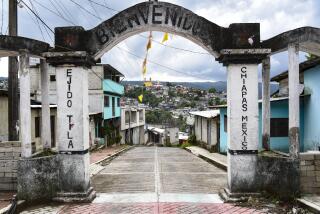An Invasion of Body Snatchers Kidnaps the Spirit of Colombia
- Share via
ICONONZO, Colombia — Weeds strangle the coffee bushes and cattle roam neglected on the Navarrete family farm. The farm is for sale, but no one will buy it--out of fear.
Farther up, in the once-thriving ranching region around Valledupar on the northern tip of Colombia, most well-to-do folks sleep with a loaded gun by the bed.
Because the rebels lurk in the hills, it is a rare family of means in this area that hasn’t had to ransom at least one kidnapped relative.
On the Navarrete farm just a few hours’ drive from Bogota, two men with shotguns kidnapped Eduardo Navarrete, a 34-year-old agronomist, in December 1994. Then, last September, Eduardo’s brother-in-law, Luis Mendez, was abducted from his nearby ranch by a band of armed guerrillas.
The captors, from the same leftist group that took Eduardo, are demanding $2 million ransom.
Eduardo’s 82-year-old father, enraged, went out and bought a sword after the abduction. He sliced the air with the blade and vowed to run the villains through. But now his feistiness is all but gone.
No country is as plagued by kidnapping as Colombia, where an estimated one in three of the world’s abductions occur. Guerrillas who control large swaths of countryside have made it a lucrative enterprise.
Ransom kidnapping by guerrillas--blamed for half of Colombia’s 10,000 reported cases since 1990--has crippled the cattle industry, forced highway projects to be canceled in mid-construction, and impoverished entire regions.
Colombia currently has more than 100 reported cases of people being held for ransom. The true number is probably much higher because scores of victimized families do not notify the authorities.
This is a country notorious for cocaine lords, corrupt politicians and endemic violence, where getting involved often means getting killed. Little surprise, then, that kidnapping has become so commonplace.
“In Colombia, we have groups that kidnap five to 10 times and never get caught,” lamented Alberto Villamizar, Colombia’s departing anti-kidnapping czar.
Created in early 1996, the organization Villamizar heads is the world’s only federal agency devoted exclusively to combating kidnapping. About 2,000 agents and 24 prosecutors are permanently assigned to it.
That’s of little comfort to Beatrice Lacouture of Valledupar. Since 1991, 43 of her relatives have been kidnapped, most of them by the leftist rebels who dominate the southern foothills of the coastal Sierra Nevada.
The reason? They refuse to pay rebel “war taxes.”
“Anyone who owns a little bit more gets clobbered,” said Lacouture, 52, who rarely ventures outside her home’s locked gates.
The Navarretes, who now live 45 miles away in Bogota, have let their land lie fallow in this lush, temperate, hilly region, which is ideal for growing coffee and bananas. Their odyssey of trying to free Eduardo has sapped their spirit, drained their bank accounts and turned family gatherings funereal.
They’ve surrendered a ransom of more than $60,000 and paid smaller sums to psychics, priests, con artists and police. But they don’t even know if Eduardo is still alive.
“You feel so defenseless, so tiny,” said Rita Mendez, wife of Luis and sister to Eduardo. In periodic telephone bargaining sessions, Rita has tried to make her husband’s captors understand that she can’t possibly pay such a sum.
“So they threaten me,” she said. They tell her Luis is a “piece of crap all ready to finish off.”
Colombian kidnappers run the political gamut, from left-wing guerrillas to right-wing paramilitary members. They also include common criminals, corrupt police officers, drug traffickers, political rivals and even victims’ relatives.
Their victims also cover a broad spectrum. Rep. Rodrigo Turbay Cote drowned in May, two years after he was abducted by guerrillas, when a boat capsized in a southern river. On July 4, police arrested three local politicians on suspicion that they paid rebels not to release Turbay. Authorities think they may have been motivated by political rivalry.
Thirteen-year-old national BMX cycling champ Andres Fernando Varela was rescued by police last November, a day after he was grabbed on his way to school in the northwestern city of Medellin.
Children are accepted prey.
The motive for kidnapping is nearly always money. Ransom demands range from several hundred to several million dollars. The average length of captivity ranges from 15 to 30 days if the captors are common criminals and six to eight months if the abductors are guerrillas.
Conditions of captivity vary widely.
Few people held by the two main guerrilla groups--the Revolutionary Armed Forces of Colombia, known by its Spanish initials, FARC, and the National Liberation Army, or ELN--complain of maltreatment. They’re usually kept unfettered in the open air and mostly just curse the boredom, bland diet and insect bites.
But kidnappers who lack a code of honor can get rough. Ex-President Cesar Gaviria’s brother, Juan Carlos, was kidnapped last year by a little-known outlaw group and forced to endure two months in a cramped underground pit. He could barely walk when he was freed.
At least he survived. About 10% of the kidnap victims end up dead.
For example, Frank Pescatore Jr., a 40-year-old American geologist, was seized for ransom in December near a northern coal mine by FARC rebels. Colombian officials believe Pescatore, son of a Long Beach Township, N.J., commissioner, was killed trying to flee.
The economic impact of this 20-year-old epidemic is severe.
“Nowhere else has kidnapping achieved this magnitude, scale and, indeed, sophistication,” said Brian Jenkins, deputy chairman of the international security firm Kroll Associates. “It’s a growing enterprise.”
Many multinational corporations refuse to open offices in Colombia, and expatriate executives and wealthy Colombians secure multimillion-dollar kidnap-insurance policies and move about with bodyguards.
Mostly, though, this crime has deeply demoralized Colombians.
“State agencies are incompetent, and the public’s complete lack of solidarity allows kidnappers to more or less do what they please,” said Augusto Perez, a university psychology professor.
Frida Spiwak, one of dozens of wealthy Jews kidnapped in the early 1980s, emigrated after being ransomed for a half-million dollars. She recently returned to Colombia and, as one of 30 psychologists in the anti-kidnapping czar’s office, now treats people for kidnapping trauma.
Spiwak, who has counseled Vietnam War veterans and victims of torture, incest and family violence in the United States, insists that nothing scars the psyche like a prolonged kidnapping.
“I’ve had people grab me like a child,” said Spiwak, clasping a reporter’s shirt and mimicking the pleas: “ ‘Help me, doctor! Please help me!’ ”
In a display of public outrage rare for Colombia, about 500,000 people marched against kidnapping in five cities last December.
The organizer, the Pais Libre foundation, lobbied successfully for a 1993 law that nearly tripled prison terms for kidnappers to 25 to 60 years. Nevertheless, judges still mete out sentences averaging nine years, said foundation director Francisco Santos.
In the United States, convicted kidnappers nearly always get locked up for life.
Like the Navarretes, most Colombian kidnap victims are people of modest means. Abductions of foreigners get more attention and fetch ransoms averaging $1 million, but they account for only about 1% of the cases.
Kidnapping’s upsurge coincided with Colombia’s drug-trafficking bonanza, and while anti-narcotics efforts get tens of millions of dollars from foreign donors, the war on kidnapping is bootstrap.
The anti-kidnapping czar’s office so far has received just $2 million to combat a crime that Villamizar estimates reaps guerrilla groups alone from $120 million to $150 million a year.
Maj. Flavio Buitrago, commander of Bogota’s anti-kidnapping police, said his department is woefully short of motorcycles, cellular phones and radios. It also lacks money to pay informants.
Over the last two years, Villamizar said, Colombia’s 24 anti-kidnapping units have made an unprecedented 300 rescues. Only a handful, however, involved people being held by guerrillas. In several cases, ex-police officers were among the kidnappers.
A common criminal negotiating a ransom by phone won’t talk more than two minutes because he knows the call is likely to be traced. But phone haggling with rebels typically lasts an hour or more because government troops rarely venture into guerrilla strongholds.
“They don’t care in the least if their location is pinpointed by satellite,” said Perez, the Bogota professor.
For anyone with any amount of wealth, airplanes are the only safe mode of travel in most of Colombia.
In one rebel-dominated northern region, a new style of kidnapping came into vogue last year. Guerrillas would brazenly stop four or five cars at a time on a major highway, grab one occupant from each car and send the others for ransoms averaging $10,000.
Fearing rebel abduction or worse, thousands of rural landholders in such regions have not visited their ranches in two or three years. Some send video-camera-toting proxies instead. Still other ranchers make regular payments to the guerrillas, known by the telling euphemism vacuna, or vaccination.
“Those who negotiate with the guerrillas always end up giving more and more until it hurts them,” said Hernan Araujo, president of the cattlemen’s association in the northern state of Cesar.
In huge areas of the Colombian countryside, the only challenge to rebel rule for the last decade has been by landowner-bankrolled paramilitary bands, who kill accused guerrilla sympathizers. But the rebels fight back, burning ranches and stealing and killing the cattle of suspected paramilitary patrons.
Paramilitary leaders kidnapped five relatives of rebel leaders during the last year and freed them just before Easter, saying they wanted “to make the subversives feel the pain” that kidnapping produces.
But FARC commander Raul Reyes, in a telephone interview from an unspecified Latin American country, defended the group’s use of ransom kidnapping as a “war tax.” He said the group targets only people who support the Colombian state financially.
ELN commander Manuel Perez calls his group’s kidnappings “political detentions,” tools in its battle “against foreign dependence and the dominance of the oligarchy.”
“We impose war taxes far inferior to those the government imposes. And we treat prisoners with dignity,” he said in a September newspaper interview.
But politics is of little interest to the Navarrete family now.
The last proof Eduardo was alive was a grainy photo delivered five months into his abduction by his FARC rebel captors. It shows Eduardo holding a newspaper and smiling. He appeared to have lost weight, and his hair was longer.
After selling land and borrowing cash, in mid-1995 the Navarretes had an emissary deliver a sack containing $60,000 to a midnight rendezvous with the kidnappers.
“The next day, we waited and waited for a phone call, anything. But nothing. Days, weeks and months passed, and we didn’t hear a thing,” said Eduardo’s 70-year-old mother, Rita, her voice quavering.
Led by Rita Navarrete’s eldest son, German, the family continued to follow every lead and paid out several thousand dollars more, mostly to what experts call “the vultures of kidnappings”--people who prey on a family’s desperation.
German bankrolled police agents who claimed to know where Eduardo was being held, then came up empty-handed.
His mother tried the paranormal, paying a handful of psychics and even a Roman Catholic priest who paused a moment with his eyes closed after being shown a photo of Eduardo, then pronounced: “He’s dead.”
Rita Navarrete is still taut with panic and fear.
In April, extortionists who claimed to have Eduardo began calling. When she demanded proof that her son was still alive, they told her he was dead and demanded cash for the body. Cases of families paying for the corpse of a loved one slain by kidnappers are not uncommon in Colombia.
Rita Navarrete said she sometimes loses hope, but she still won’t let Eduardo’s six siblings disturb anything in his room--or even ride his bicycle. And she’s on the phone twice a week to officials pleading for help.
German wonders whether the family erred by reporting Eduardo’s kidnapping.
Ten days after Eduardo’s abduction, police captured one of the kidnappers when he called the family from a pay phone. German believes that angered rebel leaders, though the captured man was a low-level guerrilla grunt.
Eduardo’s sister, Rita Mendez, and her two teenage children live off money from her parents while they wait to hear about Luis Mendez’s fate. She has never held a job in 20 years of marriage and she’s not going to look for one now, even if it might help her meet the payments of $5,000 a month that her husband’s captors now demand.
Asked how it feels to have two loved ones kidnapped, Rita Mendez prefers to talk about her 82-year-old father, Melosio.
“My papa is really demoralized. He won’t go out to the farm. He doesn’t want to do anything anymore. If he didn’t have so much mettle, he’d die.”
Rita Mendez becomes animated describing how, after her brother was abducted, her father bought a sword and began slicing the air with it, imagining a day of reckoning.
“ ‘This is for the day they tell me, “This is the man who kidnapped, who killed, Eduardo,” he said. “I’ll bury the sword in him and run it all the way through,’ ” she said, laughingly quoting her father and thrusting an arm forward in the patriarch’s imaginary coup de grace.
More to Read
Sign up for Essential California
The most important California stories and recommendations in your inbox every morning.
You may occasionally receive promotional content from the Los Angeles Times.










